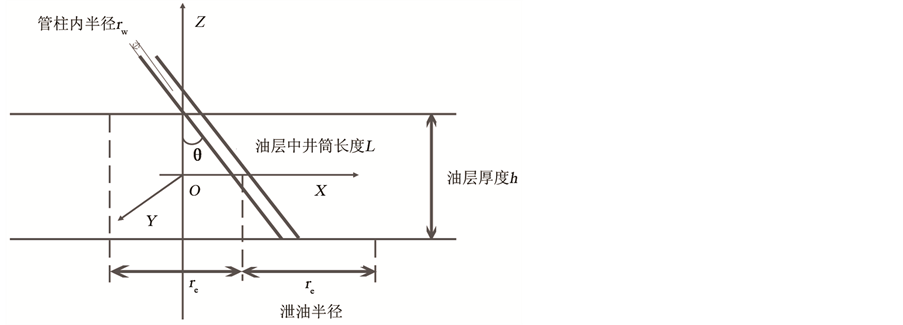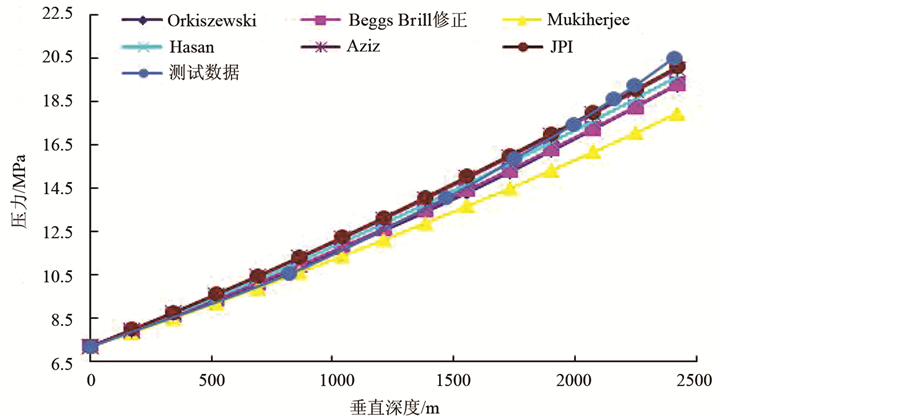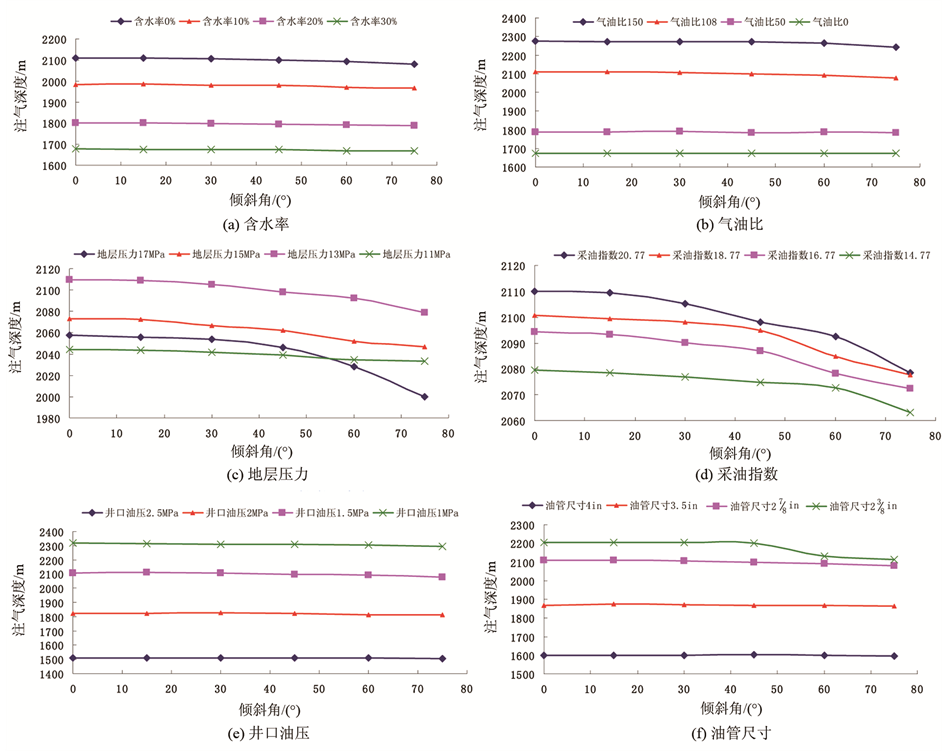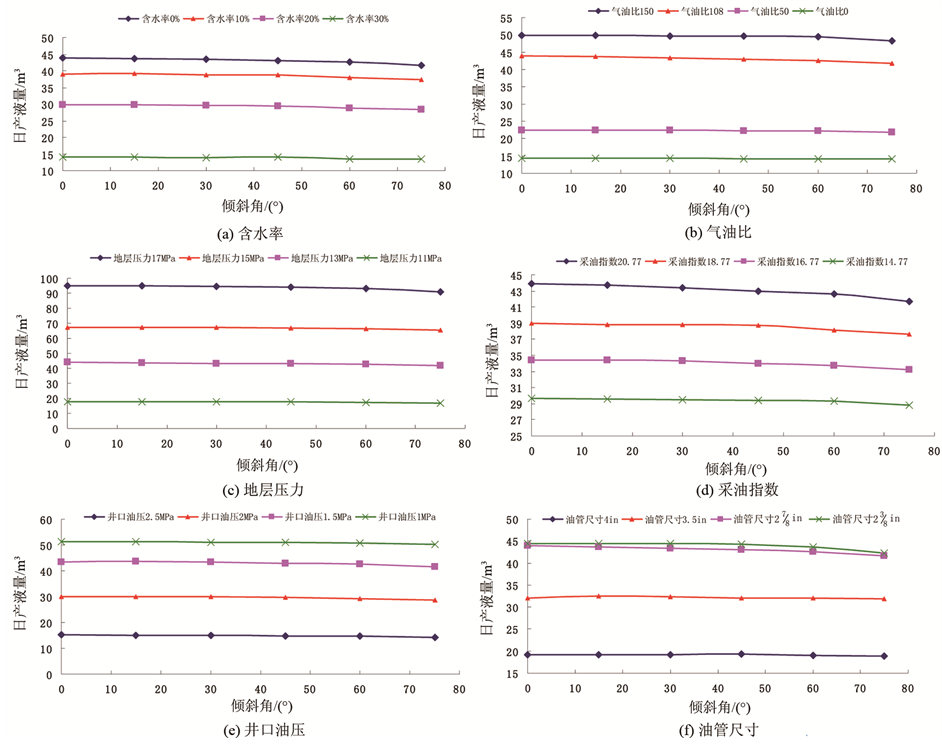气举采油是依靠从地面注入井内的高压气体与油层产出流体在井筒内混合以降低液柱流体的密度,从而降低对井底的回压,达到将井内原油举升至地面的一种采油方式。随着钻井技术的不断进步,复杂结构井的钻井技术越来越成熟。近年来,大斜度井、水平井和分支井越来越多,这也对油气田开发中的采油工艺技术提出了越来越高的要求。大斜度井、水平井和分支井的井身结构不再如直井那么简单,而对于井身结构比较复杂的油井的采油方式的优选也越来越重要,尤其是对于高产量、高气油比、出砂的井,目前还没有特别经济高效的开采方式,常规的电潜泵、有杆泵泵效低,故障频繁,目前情况下气举成为了最好的开采方式。气举采油井筒中没有运动部件,是机械采油法中对油井生产条件适应性较强的一种。随着其技术的发展和配套技术的不断完善,应用也越来越广泛。目前,国内外气举采油技术在大斜度井、水平井中均有应用,尽管如此,针对大斜度井等复杂结构井中的气举工艺的优化设计理论研究较少。而一口气举井工作状况的好坏,在很大程度上取决于气举井工艺参数的设计。一般来说,工艺参数设计合理,则气举工作效率就高;反之,则工作效率就差。
鉴于此,笔者从倾斜井流入动态、倾斜井筒多相管流 [1] [2] [3] 和气举设计理论 [2] [3] [4] [5] [6] 出发,以某油田一口倾斜井为例,展开了倾斜井气举设计与直井气举设计差异对比研究,以及倾斜井气举设计敏感参数分析研究。
2. 倾斜井气举优化设计理论
由于倾斜井的应用越来越多,因此考虑倾斜井在气举设计方法上与直井的差异显得越来越重要。而倾斜井气举设计的研究涉及到3个方面:倾斜井流入动态方法、倾斜井筒多相管流计算方法和气举设计方法。
2.1. 倾斜井流入动态方法
如图1所示,因井身斜穿油层,倾斜井中从地层向井的渗流关系比直井复杂。倾斜井的向井流动态关系预测已有许多方法,比较典型的有Van der Vlis A. C. 等人提出的等效半径方法 [7] 、Cinco-Lee法 [8] 、Besson法 [9] 和渗流场叠加模型 [10] 。

Figure 1. The schematic diagram of deviated well
图1. 倾斜井示意图
2.2. 倾斜井多相管流计算方法
准确地预测倾斜井筒压降变化是进行油井自喷、人工举升产量预测和参数优化设计的基础和依据。尽管倾斜井筒多相管流的研究持续了很长时间,在多相管流压力计算方面有了多种方法:如 Beggs-Brill [1] , Hagedorn-Brown [11] , Orkiszewski [12] , Aziz-Govier-Fogarasi [13] , Hasan-Kabir [14] , Duns-Ros [15] , Taitel-Barnea-Dukler [16] , Ansari-Sylvester-Sarica [17] , JPI [18] , Hong-Quan Zhang [19] 等,但大多是在垂直管实验基础上得到的,能用于不同倾斜角度条件下的多相管流压力计算方法并不多,目前被应用较多的有Beggs-Brill [1] 和Brill-Mukherjee [2] 两种方法,除此之外,对于不同倾角的井筒压力计算的另一种处理办法是将在垂直井压力计算中常用的方法用倾角进行修正,修正后用于倾斜自喷井、气举井等的压力计算。因此,目前常用的倾斜井多相管流压力预测方法有6种:JPI、Beggs-Brill 修正、Mukherjee-Brill, Hasan, Aziz和Orkiszewski,具体选择哪种方法需通过现场实测数据检验验证。
2.3. 倾斜井气举设计方法
常用的连续气举设计方法有降压设计方法和变流压设计方法 [6] 。降压设计方法一般是在地面注气压力比较充足的情况下使用,变流压设计方法一般是在地面注气压力相对不太充足的情况下使用。其中降压设计方法又可细分为3种 [20] :打开压力等间距降压设计、关闭压力等间距降压设计、非等间距降压设计。关闭压力等间距降压设计计算速度快,可以保证地面关闭压降是等梯度,且更方便于在地面判别是哪级阀注气生产和控制,应用最为广泛。笔者将采用关闭压力等间距降压设计进行倾斜井气举设计。
以注气量为目标进行设计,气举参数设计敏感性分析步骤如下:
1) 通过给定油井油藏参数、流体参数、井身配置参数、井口参数、目标注气量等,采用关闭压力等间距降压设计进行直井、倾斜井气举设计,得到各级阀深度及调试参数,以及对应可以达到的产液量参数;
2) 记录目标注气量条件下对应设计中最后一级气举阀注气深度及所能达到的产液量大小;
3) 给定不同目标注气量,分别进行步骤1)、2),绘制出不同目标注气量条件下气举设计所能达到的注气深度、产液量大小。
3. 实例计算
某油田一口气举井X,测试层位为Ed1 (东一段),测试井深2975.13 m (人工井底),地层平均孔隙度24.47%。具体的层位测井解释数据、自喷求产测试解释数据及压力温度测试数据见表1和表2。
表1. 测试层数据

Table 2. The tested data of pressure and temperature
表2. 压力温度测试数据
3.1. 倾斜井产能预测方法验证
根据X井测试层数据,上面几种倾斜井产能计算方法的计算结果见表3。

Table 3. The comparison of production methods for deviated well
表3. 倾斜井产能计算方法对比
通过与实际试采资料进行对比分析,结果表明等效半径方法(Van der Vlis A. C.等人)的计算结果比较符合实际。
3.2. 多相管流计算方法验证
根据X井压力测试数据,上面几种多相管流压力计算方法的计算结果见图2和表4。

Figure 2. The diagram of comparison of multiphase pipe flow pressure calculation methods for deviated well
图2. 倾斜井多相管流压力计算方法对比图

Table 4. The comparison of multiphase pipe flow pressure calculation methods for deviated well
表4. 倾斜井多相管流压力计算方法对比
通过与实际测试数据进行对比分析,结果表明Aziz多相管流计算方法的计算结果比较符合实际。
3.3. 直井、倾斜井气举设计对比及敏感参数分析
1) 根据优选得到的倾斜井产能预测方法和多相管流压力计算方法,采用关闭压力等间距降压设计法以与X井同等垂深的直井进行直井气举设计和以X井进行倾斜井气举设计,设计参数见表5,设计结果见图3、图4和表6。可以看出,在相同条件下,倾斜井气举设计所能达到的注气深度(垂深)和产液量较直井气举设计所能达到的注气深度(垂深)和产液量小。

Figure 3. The gas lift design of the vertical well with the same vertical depth in Well X
图3. 与X井同等垂深直井气举设计图

Figure 4. The gas lift design of Well X
图4. X井气举设计图
表5. 气举设计参数

Table 6. The comparison of production by gas lifting in different wells
表6. 不同井型气举设计对比
2) 根据优选得到的倾斜井产能预测方法和多相管流压力计算方法,在注气量为2000 m3/d,井口油压为1.5 MPa等条件下采用关闭压力等间距降压设计法,以与X井同等垂深的不同倾斜角度倾斜井进行气举设计参数敏感性分析,设计结果见图5、图6所示。

Figure 5. The gas injection depth changing with the dip angle of deviated well under different sensitivity parameters
图5. 不同敏感性参数下,注气深度随倾斜井倾斜角度变化情况

Figure 6. The fluid production changing with the dip angle of deviated well under different sensitivity parameters
图6. 不同敏感性参数下,产液量随倾斜井倾斜角度变化情况
从图5、图6中可以看出,在相同条件下,气举所能达到的注气深度(垂深)和产液量随着倾斜角度增加逐渐减小,因此可知,要达到相同的目标注气深度,实现目标产量,倾斜角度越大所需要的注气量越多。同时从图中可以看出,含水率、气油比、井口油压、油管尺寸是气举设计注气深度的敏感性参数,地层压力、采油指数对气举设计注气深度相对不敏感,尽管如此,含水率、气油比、井口油压、油管尺寸、地层压力、采油指数均是气举设计产液量的敏感性参数。另外,从图6(f)中可以看出,减小油管尺寸能增加注气深度和提高产液量,但是到一定程度(2⅜in、2⅞in)后,再减小油管尺寸对注气深度和产液量的增幅效果不大。
4. 结论
在所给倾斜井气举优化设计理论基础上,通过某油田一口实例井进行计算和现场实测数据对计算方法进行验证优选,进而进行直井和倾斜井气举设计对比分析,以及倾斜井气举设计敏感参数分析,得到了如下结论。
1) 在相同条件下,倾斜井气举设计所能达到的注气深度(垂深)和产液量较直井气举设计所能达到的注气深度(垂深)和产液量小。
2) 在相同条件下,气举所能达到的注气深度(垂深)和产液量随着倾斜角度增加逐渐减小,即要达到相同的目标注气深度,实现目标产量,倾斜角度越大所需要的注气量越多。
3) 含水率、气油比、井口油压、油管尺寸是气举设计注气深度的敏感性参数,地层压力、采油指数对气举设计注气深度相对不敏感,尽管如此,含水率、气油比、井口油压、油管尺寸、地层压力、采油指数均是气举设计产液量的敏感性参数。
4) 减小油管尺寸能增加注气深度和提高产液量,但是到一定程度后,再减小油管尺寸对注气深度和产液量的增幅效果不大。